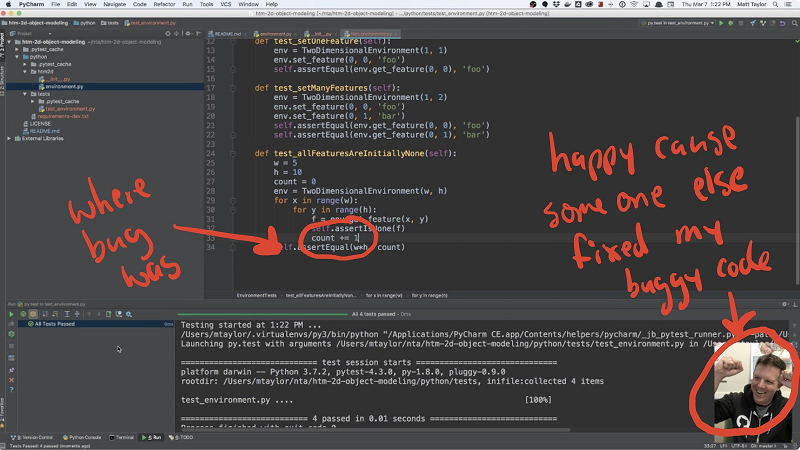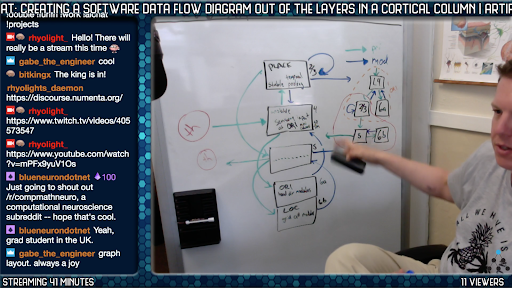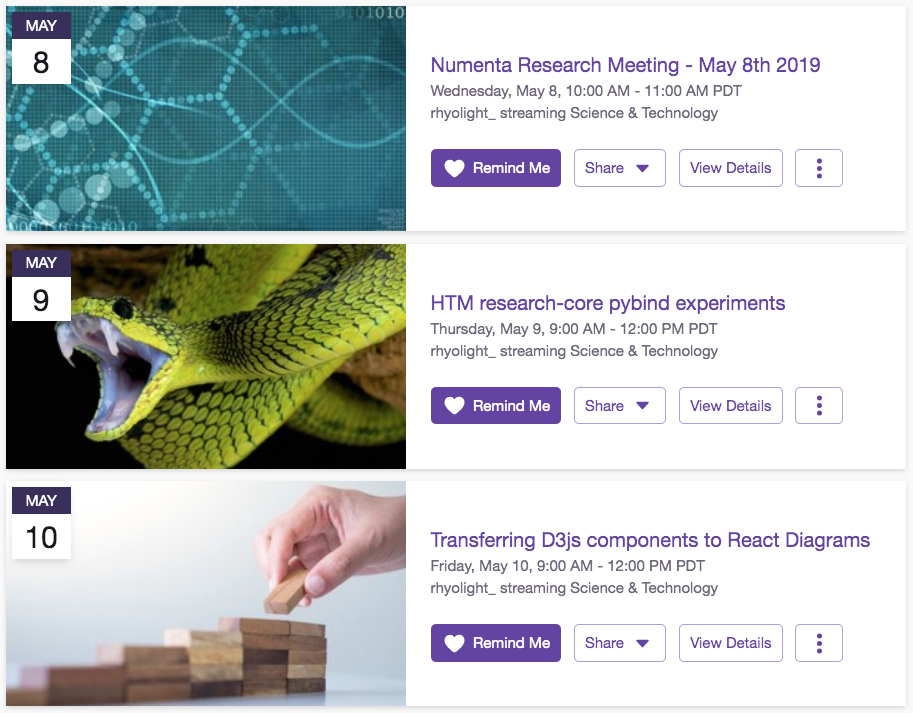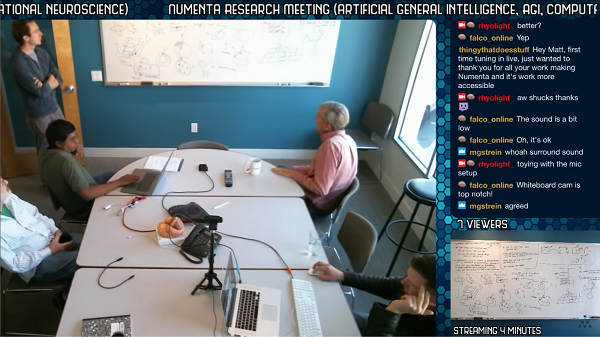Since March, I’ve been live-streaming as much of my work as possible on a platform called Twitch. You might have heard your kids talking about it (at least, that’s where I heard about it). I was initially surprised when learning about Twitch that there was so much interest in watching other people play video games! The platform is fine-tuned to give video gamers and their (sometimes massive) live audiences the ability to interact.
It took me awhile to understand why Twitch was important. The first indication was the introduction of a “Science & Technology” category on the platform. When a Twitch creator starts a live stream, they must choose a category, which is usually a popular video game like Overwatch or Fortnite. So the “Science & Technology” category was intriguing, and I started watching. I saw people fixing watches while chatting about philosophy with viewers who seemed to be conversing with them via an embedded chatroom. There was a mechanic live-streaming his work day. His legs were sticking out from underneath a red car before he appeared with obligatory grease stains on his face. People were suggesting what type of music he should listen to in his shop. I also saw lots of people writing software, or as they called it, “live-coding”. Most of the live-coders were either game developers or web developers, and Twitch gave them a unique connection with a grass-roots community. And they all seemed to know their audience well.
Something strange was happening here. This was not just a live-stream, it was more interactive than that. Live-streamers were rewarding members of their audience in unique ways, and I could tell communities were being built. These were not just chat rooms, these channels were filled with people who seemed invested in the success of the live-streamer.
As the Community Manager of Numenta, I had to try it out. In my very first stream, this happened. I had not even figured out how to display the chat window in the video, but someone in my chatroom had found a bug in my code before I could.

Figure 1: The first time I live-streamed on Twitch, someone pointed out a bug in my code.
In software engineering, there is a concept called “pair programming”. It’s simple to understand. You sit together with another software engineer, discussing solutions to problems, and take turns with the keyboard implementing solutions in code. That’s what Twitch feels like to me. I feel like I’m collaborating with my audience, because they can speak back. It’s a good feeling, and I know the folks I’m connecting with in my audience enjoy it, because they keep coming back. In fact, many of them are contributing code back to my projects. They understand my goals as a software engineer because they can ask me questions as I’m building solutions. The more I use Twitch, the more it seems like the collaborative remote environment of the future. I think it could be used by large organizations to hold collaborative work sessions. I think it could even be used by teams of remote software developers, all working in a virtual “bullpens” to build code together.
The Value of Public Failure
When you are watching a recording of someone online, unless it’s a blooper reel, you’re likely not going to see that person fail at the task they’re attempting. They will have recorded many takes of the scene and edited out anything embarrassing. But with a live-stream, you just can’t do this, ever, at all. The worst thing — the scariest thing — and the thing that will keep most people from live-streaming their work is the fear of public failure. This was hard for me to accept, that I was going to fail, without a safety net, live on the internet. It could happen at any time, in any project. It might be as simple as my ISP cutting my internet connection, or that I just cannot remember what I was just talking about and can you please excuse me while I mute the mic and have a nervous breakdown stage left?!

Public failure is really uncomfortable, but what sometimes happens afterwards on Twitch is amazing. The community helps, in real time. They see you failing, and sometimes one of them knows exactly what the problem is. They know why you’re failing, and they tell you how to succeed. This is the best feeling of all. It’s why it is worth it to me to fail to do something for nearly an hour. The audience keeps coming back, encouraging me to succeed, and helping when they can.
“Those folks in the audience aren’t critics, they’re fans.”
As you watch the streams on Twitch, you start to realize that Twitch is closer to real-life than any other form of social media. It is the closest type of mass-audience interaction aside from having a group of people sitting in front of you watching as you work. And while the interaction started in my mind as the scariest thing about Twitch, it has now become the most comfortable thing. Those folks in the audience aren’t critics, they’re fans. They have invested in me, my company, and our mission by watching me on Twitch. They know the things I’ll be working on, and they come by to learn from me and help me succeed. It is the type of win-win situation you cannot ignore when you see it.
Storming the Castle
It did not take me long to realize that very few Twitch “content creators” are talking about neuroscience, and practically no one at all is discussing artificial intelligence or machine learning. OpenAI has a Twitch channel, but they use it in the standard fashion: playing competitive video games. The field is completely empty, and the equipment locker’s wide open. I have free reign to create as much neuroscience / AI content as I want on this platform, and there is no one providing competing content! I’m still amazed more software development communities have not jumped on board the Twitch bandwagon.
So I decided to buckle down and create some shows. If you are new to Twitch, it helps to think about it more like cable television than YouTube. The valuable thing about Twitch is the live interaction. Viewers flip through channels looking for interesting live content. So it helps to have a schedule so return viewers know when to expect you to be live. I try to keep all my regular shows on my events page. This way viewers can plan ahead to catch my show when I’m live. My weekly schedule might change over time, but I generally create three types of content:
- Artificial Intelligence / Neuroscience Chat
- HTM Project Live-Coding
- Numenta Research Meetings
In the AI / Neuroscience Chat, I will pick a topic ahead of time and put it on my events page so people know what I’ll be talking about. Then during that hour, we’ll investigate the topic together. I will lean on folks in chat to help me understand something if I need help. I will usually tag my live-stream with AMA (Ask Me Anything) so my viewers know I am open for chat on other topics as well. (Viewers usually stay on topic.)
When I work on HTM Project Live-Coding, I’m collaborating with others on a variety of HTM-related projects. I’m currently working on several projects, including Building HTM Systems and ongoing Python 3 community projects. My best work sessions are when I have people from HTM Forum joining to help me accomplish something. This seems to happen quite a bit now, and it has really helped me make stronger connections with the technical builders in our awesome community.
Here is an example of my show schedule:

Figure 3: A Typical week of live-streaming for me.
A Window into Research at Numenta
The last type of “show” I live-stream is the Numenta Research Meeting. These meetings have happened at Numenta for as long as I can remember, but I’ve never been in a position to make them public. I have been attending these meetings for a long time, and since I started streaming my work days on Twitch, I wondered what Jeff would think if I just started streaming my view of the research meetings. I knew that the HTM Forum audience would really appreciate having a way to keep up with the most recent theories, but I was wary of distracting the research team. So I talked to Jeff about acting like a buffer between the community and the research team. I would stream my view like I usually do on Twitch during these meetings. My audience could discuss the meetings in chat, but I would not generally interrupt the meetings with comments from viewers. After the meetings, we could take the conversation to the forums.

Figure 4: Marcus hopes no one notices he forgot to carry the 1.
We’ve been doing this weekly since April, and so far it has turned out great. I have noticed that some community members follow our work very closely, and this is a way for them to stay abreast of relevant topics and avenues forward. We at Numenta cannot see all the puzzle pieces at one time, so if others can help by researching other areas, we’ll be all the wiser.
Making our research meetings open for public discussion is another way we strive for transparency in our work. We believe that understanding how intelligence works in the brain is important work, and making this research open to anyone is a way to preserve knowledge for the future of humanity.
This has been an interesting experiment for Numenta and myself, and I think we’re going to continue looking for innovative ways to share knowledge and build communities online. Twitch helps us with both of these things.
Twitch Promotes Humanity
I think the Twitch platform has a bright future. I have already benefited from using it in many ways. The more people we have creating content on Twitch, the better it gets. Imagine if there were 10 shows live right now streaming educational content on your favorite subject! So I’ll leave you with a call to action. First of all, watch my Twitch stream. Don’t just watch, but join the platform and comment. Come chat with me during my stream. Be a part of this community we’re building online. Not just a random comment on our YouTube channel, but a real person talking to another real person on a platform that exposes our humanity through collaborative communication.
Better yet, start your own Twitch channel! Are you good at something? Passionate about something? There are people who will watch you fail at doing it! ? I encourage you to take what you’re good at and live-stream it. You’ll be surprised at who shows up to watch, and how much they might help you out. I think the future of human education is more grass-roots collaboration and less standardized education. And the best way to learn is by teaching something.
When you create a Twitch account and start playing Fortnite, no one expects you to be an expert gamer. They just want you to be you, and have fun. It’s the same with the “Science & Technology” category. No one expects you to be the best engineer, watch-maker, programmer, mechanic, etc. They just appreciate that you’re there, doing what you love to do, and sharing it with a community of like-minded humans.

